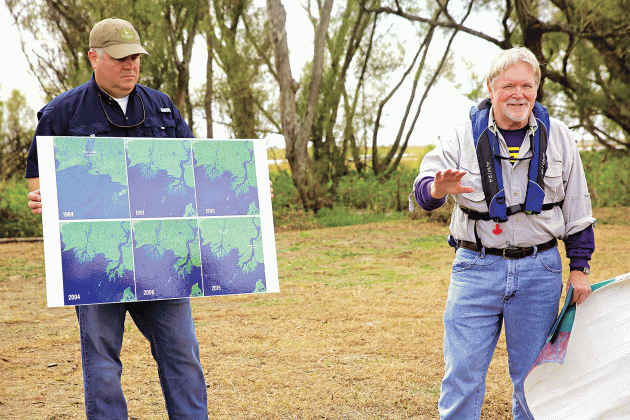
Bill Decker/
Academics, environmentalists and a government official led reporters back to newly created land in St. Mary Parish, hoping they’ll see lessons about how some of Louisiana’s coast might be saved.
The tour of the Wax Lake Delta southwest of Centerville on Nov. 22, accompanied by handouts titled “Restore the Mississippi River Delta,” was a reminder that Louisiana’s ravaged coastal land has found a way to restore itself here. That’s true almost nowhere else on the coast.
The tour was also a sign that people are watching what happens at Wax Lake — even from space.
The National Aeronautics and Space Administration uses satellites to collect data on the way Wax Lake develops. Robert Twilley, executive director of the Louisiana Sea Grant College program and a published expert on the way deltas develop here, in Latin America and the Pacific, told the tour-goers that the satellites measure factors such as sediment density to feel the pulse of the delta creation.
“The part of the Atchafalaya you’re going to see today is one of the few places along the coast where the delta is building,” Twilley said.
Flood control measures and other factors have robbed Louisiana of land equal to the size of Delaware since the 1930s. In many places, notably the Terrebonne basin to the east, the sediment that renews wetlands and accumulates at stream mouths to form new land has been diverted elsewhere.
So saltwater intrusion, natural events such as hurricanes and other processes have eroded away coastal land.
But maps that show land loss along the great Mississippi coastal plan across southern Louisiana show something else at the mouths of the Wax Lake Outlet and the Atchafalaya. They show the familiar river delta shape with fingers stretching into Atchafalaya Bay with veins of fresh water flowing through them.
The Old River control structure diverts about 30% of the water headed downstream in the Red and Mississippi rivers into the Atchafalaya. About 20% percent of that flow comes down the Wax Lake Outlet, which was dredged out of the wetlands in the 1940s to help protect the Morgan City area from high water.
The sediment that is denied to some portions of the Louisiana coast is allowed to reach the Atchafalaya and the Wax Lake Outlet.
Scientists noticed mud building up at the end of the outlet in the 1950s. Then, after the 1973 flood, land began to protrude from the water near the Atchafalaya Wildlife Management Area down the outlet from the Intracoastal Waterway.
On Friday, the boat tour made a stop at the land, which now is about as wide as a tennis court is long, and extends as far as you can see in either direction. The land didn’t exist when some of the people on the tour were in high school.
Scientists have found that the Wax Lake and Atchafalaya deltas added about 13 square miles of land 1989-95. Then it lost 2 square miles 1999-2004, when the coast was hit by hurricanes Isidore and Lili and when there were no major floods, NASA said.
Now the two deltas add about a square mile of new land each year.
The growth is about more than just statistics on land loss or land gains. The creation of new wetland is the signal for another natural process, species succession, to begin. Twilley said that as the land accumulates, water plants, then shore plants like cattails and finally trees take over the new land.
That creates habitats for species such as ibises. Erik Johnson, director of bird conservation for Louisiana Audubon, said ibis numbers here have grown as the land has grown.
Another species stands to benefit, too, Twilley said.
The trees that represent the apex of the succession process offer the best protection against a hurricane’s winds and its storm surge, Twilley said.
“Morgan City,” he said, “this is something you’ve got to treasure.”
The tour was conducted by Twilley; Bren Haase, executive director of the state Coastal Protection and Restoration Authority; Brad Barth, the CPRA’s operations assistant administrator; National Wildlife Federation coastal scientist Alisha Renfro; Chris Macaluso, director of the Center for Marine Fisheries; and Johnson.
